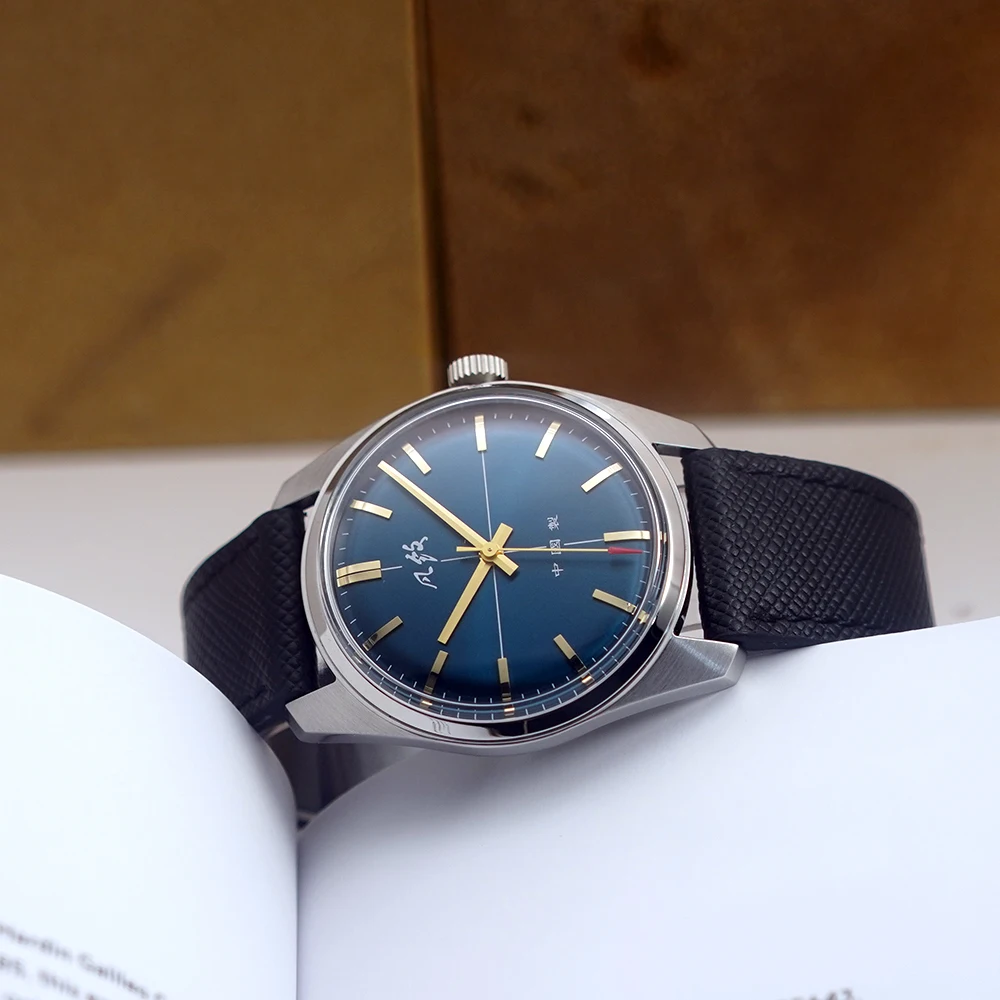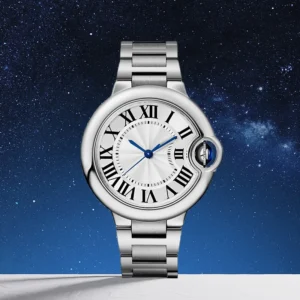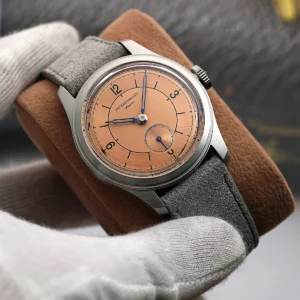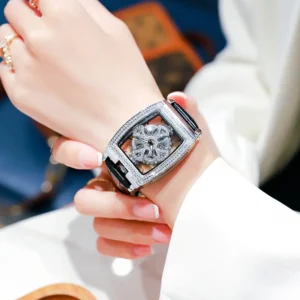Understanding the Essence of a Dress Watch
A dress watch represents the pinnacle of horological refinement—a timepiece specifically crafted for formal occasions that embodies elegance and restraint. Unlike sports watches that emphasize durability and functionality, the dress watch adheres to a philosophy where less is undeniably more. These watches aren’t designed to make bold statements or showcase technical prowess; rather, they complement formal attire with understated sophistication.
At its core, a dress watch follows the principle that it should enhance your overall appearance without drawing undue attention. The defining characteristics of a classic dress watch remain remarkably consistent—clean dials, slim profiles, and refined proportions. These timepieces whisper rather than shout, making them the perfect companion for business meetings, formal dinners, or black-tie events.
While watch trends come and go, dress watches maintain their relevance through adherence to timeless design principles. The most iconic examples in this category have remained virtually unchanged in their fundamental appearance for decades, demonstrating the enduring nature of elegant simplicity. Understanding what defines a classic dress watch helps collectors and enthusiasts appreciate why these timepieces form an essential cornerstone of any well-rounded watch collection.
Throughout this guide, we’ll explore the specific features that distinguish dress watches from other categories—from their slim cases and minimalist dials to their restrained complications and elegant straps. By examining these elements individually, you’ll develop a deeper appreciation for how each component contributes to the harmonious whole that makes dress watches the embodiment of horological refinement.
The Defining Case Characteristics
The case of a dress watch serves as its architectural foundation, embodying principles of restraint and elegance through several key characteristics:
Slim Profile: The Hallmark of Elegance
Perhaps the most defining feature of a dress watch is its thin profile. Traditionally, dress watches maintain a case thickness under 0.4-0.5 inches (10-12mm), with many luxury examples measuring significantly less. This slenderness serves a practical purpose—allowing the watch to slip easily beneath a shirt cuff—while also conveying a sense of refinement that bulkier watches cannot achieve.
The pursuit of thinness in case size trends for dress watches has driven innovation in movement design, with watchmakers developing remarkably thin calibers to maintain these sleek profiles. This emphasis on slimness represents the perfect marriage of form and function.
Diameter: Proportional Elegance
Classic dress watches typically feature case diameters between 1.3-1.6 inches (34-40mm), significantly smaller than contemporary sports watches. This modest size ensures the watch maintains proper proportion with formal attire and appears refined rather than ostentatious. While recent trends have seen slight increases in average diameter, truly elegant dress watches resist excessive size.
Shape and Construction
While round cases dominate the dress watch category, rectangular and square cases—often with softened corners—also maintain a strong presence in the dress watch tradition. Regardless of shape, dress watch cases feature:
- Clean lines with minimal protrusions
- Slim, unobtrusive bezels that maximize dial space
- Gently curved profiles that sit comfortably on the wrist
- Polished finishes that catch and reflect light elegantly
Materials: Traditional Luxury vs. Modern Options
Historically, precious metals defined the dress watch category:
– Yellow gold: Warm and traditional
– Rose gold: Softer, more contemporary appeal
– White gold or platinum: Subtle luxury that can be mistaken for steel
While these materials remain prestigious choices, high-quality stainless steel has become widely accepted for dress watches, offering durability and accessibility while maintaining an elegant appearance when properly finished.
The thin automatic dress watches that epitomize this category demonstrate how careful attention to case proportions creates a harmonious whole. The best examples feel substantial enough to convey quality while remaining light and unobtrusive on the wrist—a delicate balance that distinguishes truly excellent dress watches from merely adequate ones.
Dial Design: The Art of Refined Minimalism
The dial of a dress watch represents the clearest expression of its philosophy: refined minimalism that prioritizes legibility and elegance over complexity. Every element serves a purpose, with nothing superfluous to disturb its harmonious balance.
Color Palette: Understated Sophistication
The traditional dress watch color palette remains deliberately restrained:
- White: The most classic choice, providing maximum contrast and legibility
- Silver: Offering subtle texture and light play without being flashy
- Black: Providing dramatic contrast and formal versatility
- Champagne/Cream: Warmer alternatives that complement gold cases beautifully
These colors maintain their popularity in dress watch dials because they provide the perfect backdrop for both gold and steel elements while remaining eternally stylish rather than trendy.
Indices and Numerals: Elegant Simplicity
Dress watch hour markers typically follow several established approaches:
- Applied batons: Simple, polished metal markers representing hours
- Roman numerals: Traditional and formal, often in a slim typeface
- Arabic numerals: Less common but elegant when executed with restraint
- Minimal or no numerals: Allowing maximum white space for the purest expression
Whatever style is chosen, proper proportions remain essential—neither too bold nor too delicate, with careful attention to spacing and alignment.
Hand Design: Slender Precision
Dress watch hands embody elegant restraint through their proportions and shapes:
- Dauphine hands: Tapered, faceted hands that catch light dramatically
- Leaf hands: Graceful, organic shapes with gentle curves
- Baton hands: Simple, straight hands that complement minimalist dials
- Breguet hands: Featuring distinctive moon-tipped shapes for a classical touch
The finest dress watch hands feature polished finishes that enhance legibility by catching light at different angles, creating contrast against the dial without requiring luminous material.
Subtle Decorative Elements
While restraint prevails, dress watch dials often incorporate subtle decorative elements that reward close inspection:
- Guilloche patterns: Engraved geometric designs adding texture and dimension
- Sunburst finishes: Radiating patterns that play with light dynamically
- Sector designs: Concentric circles dividing the dial into elegant segments
- Applied logos or signatures: Adding dimension while maintaining refinement
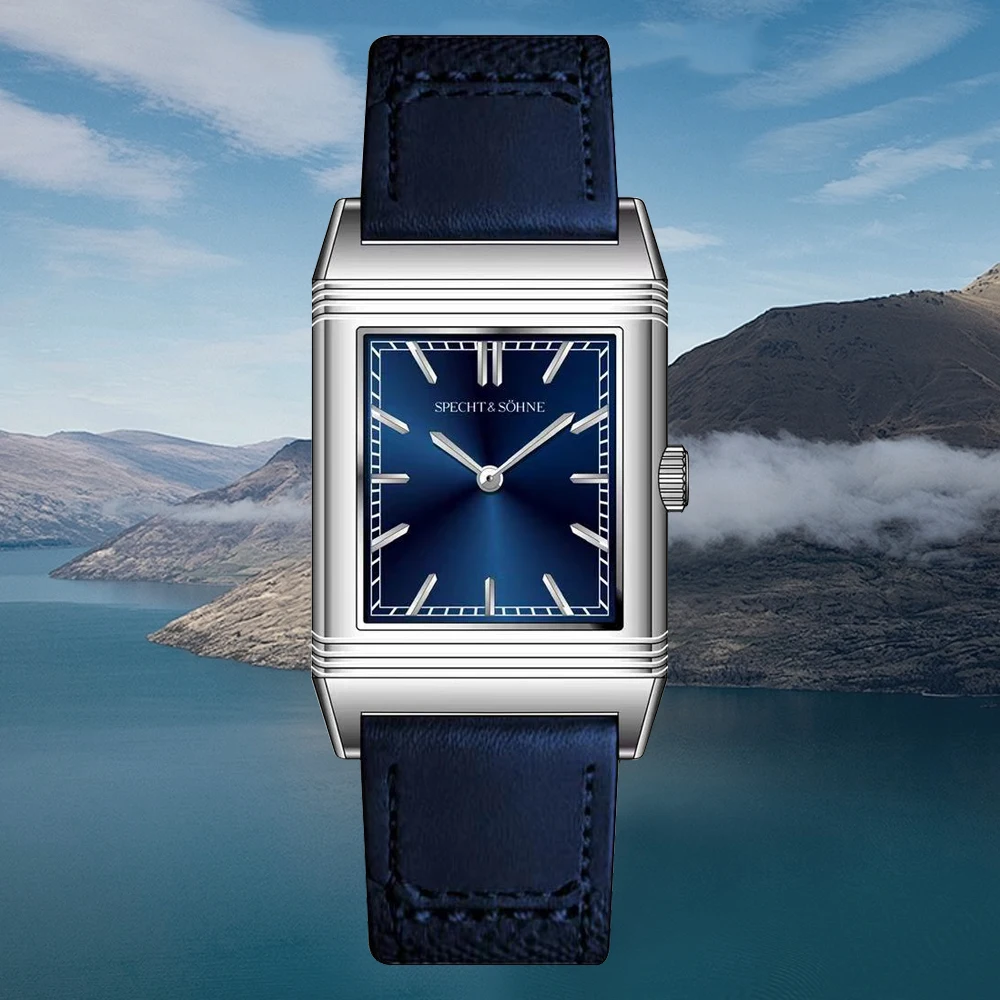
These elements reflect the minimalist automatic watches philosophy where beauty emerges from perfect proportions and thoughtful restraint rather than excessive ornamentation. The best dress watch dials achieve a delicate balance between visual interest and serene simplicity, creating timepieces that remain captivating despite—or perhaps because of—their restraint.
Complications: The Art of Restraint
Dress watches embrace functional minimalism, reflecting the philosophy that elegance comes from restraint rather than abundance. While modern sports watches often showcase multiple complications, dress watches carefully limit additional functions to maintain their clean aesthetic.
The Purist Approach
The most traditional dress watches display only hours and minutes, representing the purest expression of timekeeping. This minimalist approach creates balanced, harmonious dials without distraction. The absence of a seconds hand maintains serene dial aesthetics while staying true to the formal watch tradition.
Acceptable Complications
When complications appear in dress watches, they’re carefully selected and subtly integrated:
- Small seconds: A subdial (typically at 6 o’clock) offers the functionality of a seconds display while maintaining balance and introducing pleasing asymmetry
- Simple date display: Often positioned unobtrusively at 3 o’clock or 6 o’clock with a proportional window that doesn’t disrupt dial harmony
- Moonphase: Perhaps the most romantic complication, adding a touch of astronomical wonder while maintaining formality
The moonphase automatic watches exemplify how this celestial complication can enhance rather than overwhelm a dress watch design. The best examples integrate the moonphase display so harmoniously that it feels like an essential part of the design rather than an addition.
Integration and Balance
When complications are included, their successful integration depends on:
- Proportional sizing that respects dial harmony
- Color matching between complications and main dial elements
- Thoughtful positioning that maintains visual balance
- Restrained execution that avoids unnecessary embellishment
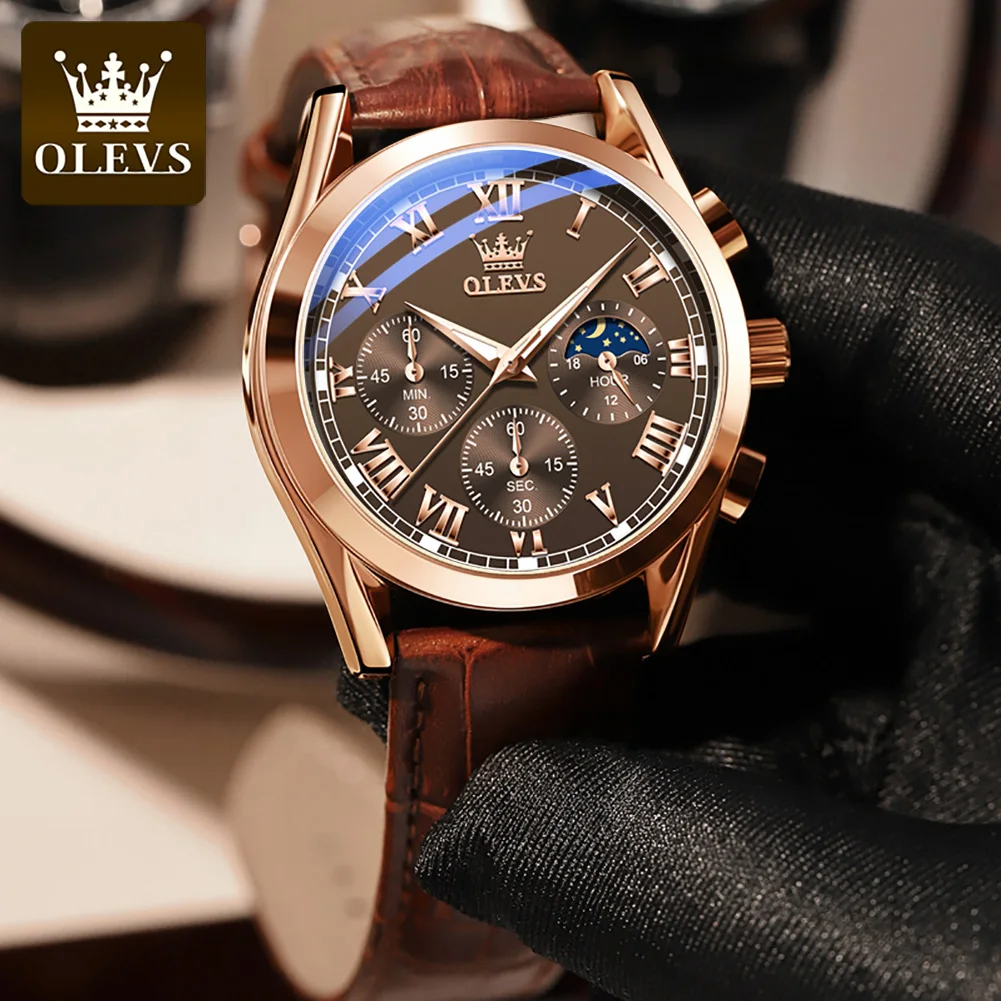
Modern interpretations sometimes push boundaries by incorporating power reserves or retrograde displays, but the most successful examples maintain the quintessential guide to dress watch features through careful execution. The complication should enhance the watch’s character without compromising its fundamental elegance.
This selective approach to complications distinguishes dress watches from their sportier counterparts. Where a dive watch’s rotating bezel or a chronograph’s pushers announce their functionality, a dress watch’s complications whisper rather than shout—revealing their sophistication only to those paying close attention.
Movements: The Heart of the Dress Watch
The movement within a dress watch represents its beating heart, embodying the craftsmanship and tradition that elevate these timepieces beyond mere accessories. While hidden beneath the dial most of the time, the movement’s quality and characteristics fundamentally influence both the watch’s performance and its physical proportions.
The Mechanical Preference
Traditional dress watches overwhelmingly favor mechanical movements over quartz alternatives, reflecting appreciation for horological craft. These movements fall into two main categories:
Manual Wind Movements
Manual wind dress watches hold special appeal for purists and enthusiasts for several compelling reasons:
- Their hand-wound nature creates a ritual of interaction between wearer and timepiece
- They typically allow for thinner case profiles by eliminating the automatic winding mechanism
- The absence of a rotor provides unobstructed views of the movement architecture through display casebacks
- They represent the oldest form of wristwatch technology, connecting directly to horological traditions
The daily winding ritual these watches require creates a personal connection that many enthusiasts find deeply satisfying—a moment of mindfulness in an otherwise hectic day.
Automatic Movements
Self-winding automatic movements offer practical convenience while maintaining mechanical prestige:
- They eliminate the need for daily winding when worn regularly
- Modern designs have become increasingly thin, minimizing compromise on case dimensions
- They represent the perfect marriage of tradition and practicality
- Their winding rotors can be beautifully decorated, adding visual interest when viewed through display backs
Movement Finishing: Hidden Excellence
Even when concealed by solid case backs, the finest dress watch movements feature meticulous decoration:
- Geneva stripes (Côtes de Genève): Parallel decorative lines on movement plates and bridges
- Perlage: Overlapping circular patterns resembling pearl overlays
- Blued screws: Heat-treated to achieve a distinctive blue hue
- Beveled edges: Polished angles catching light at the edges of bridges and plates
- Hand-engraved balance cocks: Artistic flourishes on visible components
These classic manual wind watches demonstrate how traditional finishing techniques elevate movements from mere mechanisms to miniature works of art. While such details remain invisible during normal wear, their presence reflects the integrity and craftsmanship values that define fine dress watches.
The marriage of form and function within these compact movements represents a technical achievement that shouldn’t be overlooked. Creating mechanisms that maintain excellent timekeeping while conforming to the strict dimensional requirements of dress watches requires significant engineering prowess—an achievement that deserves appreciation alongside their aesthetic qualities.
Straps and Bracelets: The Elegant Connection
The strap or bracelet of a dress watch does more than simply secure it to the wrist—it completes the aesthetic composition and significantly influences how the watch integrates with formal attire. This crucial component embodies the same principles of refinement that define every other aspect of dress watch design.
The Dominance of Leather
Leather straps reign supreme in the dress watch category for compelling reasons:
- Formality: Leather conveys sophistication appropriate for business and formal settings
- Comfort: Quality leather conforms to the wrist for all-day wearability
- Complementary: It provides the perfect counterpoint to polished metal cases
- Heritage: Continues the tradition established by early wristwatch designs
Premium Leather Varieties
The finest dress watches feature carefully selected leathers:
- Alligator: Distinctive scale pattern with natural variation and formal appearance
- Crocodile: Similar to alligator but with smaller, more uniform scales
- Calfskin: Smoother texture with subtle grain, excellent durability and comfort
- Ostrich: Unique texture from quill follicles, developing an attractive patina
Traditional Colors
While leather straps come in countless hues, dress watches typically adhere to a restrained palette:
- Black: The most formal choice, traditionally paired with white metals (steel, white gold, platinum)
- Brown: Various shades from tan to chocolate, often complementing yellow or rose gold cases
- Navy: A less common but elegant alternative that works particularly well with steel cases

Metal Bracelets: The Elegant Alternative
While leather dominates, certain metal bracelet designs maintain sufficient refinement for dress watches:
- Mesh/Milanese: Ultra-thin, tightly woven metal links creating a fabric-like appearance
- Thin, polished link designs: Emphasizing elegance over robustness
- Integrated designs: Where the bracelet flows seamlessly from the case
The key characteristics remain consistent—thinness, flexibility, and refined finishing that prioritizes elegance over durability.
Closures and Proportions
The details of strap attachment and closure reflect the overall design philosophy:
- Pin buckles: Traditional and elegant, often featuring engraved brand logos
- Deployant clasps: More convenient while preserving strap longevity, concealed beneath the wrist
- Proportional taper: Dress watch straps typically narrow from the lugs to the buckle, enhancing comfort and elegance
The classic automatic dress watches showcase how these elements come together to create a harmonious whole. The perfect strap complements rather than competes with the watch head, creating visual continuity while maintaining comfortable wearability appropriate for formal environments.
Crystal and Case Back Considerations
The crystal and case back of a dress watch might seem like secondary elements, but they significantly impact both aesthetics and functionality. These components reflect the same commitment to refinement that characterizes every aspect of dress watch design.
Crystal Selection: Clarity and Protection
Modern dress watches overwhelmingly favor sapphire crystal for several compelling reasons:
- Scratch resistance: With a hardness of 9 on the Mohs scale (second only to diamond), sapphire provides exceptional protection against everyday scratches
- Clarity: Offers exceptional transparency without distortion
- Longevity: Maintains its pristine appearance for decades with proper care
- Prestige: Considered the premium choice, befitting the formal nature of dress watches
The specific shape and implementation of sapphire crystals in dress watches typically follows one of two approaches:
Flat Crystals
- Maintain the thinnest possible profile
- Provide clean, undistorted views of the dial
- Create a modern, architectural aesthetic
Gently Domed Crystals
- Evoke vintage aesthetics with subtle curvature
- Soften the watch’s appearance with organic shapes
- Create interesting light play and reflections
Both approaches remain valid in contemporary dress watch design, with the choice often reflecting the overall design language of the specific model.
Case Back Design: Hidden Complexity
Dress watch case backs traditionally fall into two categories, each with distinct advantages:
Solid Case Backs
- Maintain the thinnest possible profile
- Provide space for personalized engravings or brand emblems
- Protect the movement from magnetism and other environmental factors
- Reflect historical dress watch traditions
Exhibition Case Backs
- Showcase movement finishing and decoration
- Reveal the craftsmanship otherwise hidden from view
- Add depth to the appreciation of the timepiece
- Create an additional dimension of enjoyment for the owner

The decision between solid and display case backs often depends on the movement’s aesthetic qualities and the watch’s intended profile. Exceptional finishing merits display, while ultimate thinness might favor a solid back. The definitive guide to dress watch design demonstrates how these elements work together to create cohesive timepieces where every detail serves the overall aesthetic vision.
Whether visible or hidden, these components reflect the watchmaker’s philosophy toward transparency—both literal and metaphorical—about the craftsmanship contained within. The finest examples strike a thoughtful balance between showcasing artistry and maintaining the slender profile that defines the category.
Comparing Dress Watches to Other Watch Categories
Understanding dress watches fully requires examining how they differ from other major watch categories. These distinctions help clarify what makes a dress watch unique and why specific design choices are made in this category.
Dress Watches vs. Sports Watches
| Feature | Dress Watches | Sports Watches |
|---|---|---|
| Case Size | Slim (7-12mm) and modest diameter (34-40mm) | Thicker (12mm+) and larger diameter (40-45mm+) |
| Water Resistance | Minimal (30-50m) | Substantial (100-300m+) |
| Dial | Clean, minimal, limited complications | Busier, functional, tool-oriented displays |
| Materials | Precious metals, fine leather | Durable materials, rubber/metal bands |
| Hands & Markers | Elegant, often without luminescence | Bold, highly legible, luminous |
| Bezel | Slim, fixed, decorative | Often functional (timing, calculations) |
| Crystal | Sapphire, sometimes slightly domed | Sapphire with anti-reflective coating |
| Movement | Emphasis on thinness and finishing | Emphasis on robustness and accuracy |
The fundamental difference lies in purpose: dress watches are designed to complement formal attire in controlled environments, while sports watches are engineered to withstand active use in challenging conditions.
Dress Watches vs. Casual Everyday Watches
Dress and casual watches occupy different positions on the formality spectrum. While casual watches borrow elements from both dress and sports designs, they typically feature:
- Medium case sizes (38-42mm)
- Versatile styling that works with business casual attire
- Greater variety in dial colors and designs
- More complications than dress watches, fewer than sports models
- Moderate water resistance (50-100m)
- Balanced proportions suitable for daily wear
The distinction between a dress watch and a normal watch often comes down to the level of refinement and restraint in design. Dress watches adhere more strictly to minimalist principles, while everyday watches permit greater expression and functionality.
Dress Watches vs. Tool Watches
The contrast becomes even more pronounced when comparing dress watches to purpose-built tool watches like divers, pilots, and field watches:
- Tool watches prioritize specialized functionality for specific environments
- Legibility under challenging conditions takes precedence over aesthetics
- Robust construction withstands impacts, pressure, and harsh conditions
- Enhanced protection against magnetic fields and other environmental factors
- Specialized features (rotating bezels, slide rules, chronographs) for practical applications
While tool watches announce their capabilities through distinctive visual elements, dress watches whisper their sophistication through restraint and proportion.
Hybrid Designs: Blurring the Boundaries
Contemporary watch design increasingly explores the space between these traditional categories. Models that blend elements—like the sports-elegant watch—challenge strict categorization while offering greater versatility. The principles of classic vs. minimalist dress watches continue evolving as designers reinterpret traditional codes for modern tastes.
Understanding these distinctions helps collectors appreciate the intentional design choices that define each category and recognize when a watch successfully bridges multiple categories without compromising its core identity.
How to Select the Perfect Dress Watch
Choosing the ideal dress watch requires thoughtful consideration of several key factors beyond simply identifying the hallmark features of the category. This process balances personal preferences with traditional guidelines to find a timepiece that both honors dress watch traditions and suits your individual needs.
Understanding Your Context
Consider how and where you’ll wear your dress watch:
- Formality level: Ultra-formal environments may call for the most traditional approach, while creative or less formal settings allow more flexibility
- Frequency of use: A watch worn daily might prioritize versatility, while an occasional formal watch can be more specialized
- Personal style: Your dress watch should complement your overall aesthetic rather than conflict with it
- Existing collection: Consider how a new dress watch fits alongside your other timepieces
Finding Your Perfect Fit
The most elegant dress watch loses its appeal if it doesn’t fit properly on your wrist:
- Case diameter: Should be proportional to your wrist size—typically covering about half to two-thirds of your wrist width
- Lug-to-lug distance: Perhaps more important than diameter, this measurement determines how the watch sits across your wrist
- Case thickness: Slimmer profiles generally appear more elegant and sit better beneath shirt cuffs
- Strap width: Should be proportional to the case size and taper gently toward the buckle
Learning how to identify a dress watch helps you recognize models that will work best for your specific needs and preferences.
Quality Indicators
When evaluating dress watches, pay attention to these markers of quality:
- Case finishing: Look for consistent polishing, sharp transitions between surfaces, and careful attention to detail
- Dial execution: Examine index alignment, printing quality, and hand finishing
- Movement quality: Consider accuracy specifications, finishing level, and service requirements
- Strap quality: Assess leather grain, stitching consistency, and lining material
Balancing Budget and Value
Dress watches exist across all price segments, from affordable to ultra-luxury:
- Entry-level ($200-$1,000): Focus on clean design, reliable movements, and versatile styling
- Mid-range ($1,000-$5,000): Expect improved finishing, better movements, and potentially precious metal accents
- Luxury ($5,000+): Look for precious metals, in-house movements, and exceptional hand finishing
Remember that a thoughtfully designed watch at any price point can provide satisfaction when its qualities align with your personal values and needs.
Classic Automatic Dress Watches, Day Date Automatic Watches, Perpetual Calendar Automatic Watches
Price range: $540.60 through $574.60 Select options This product has multiple variants. The options may be chosen on the product pageClassic Automatic Dress Watches, GMT Automatic Watches, GMT Pilot Watches
Price range: $1,240.86 through $1,463.33 Select options This product has multiple variants. The options may be chosen on the product pageClassic Automatic Dress Watches, Thin Automatic Dress Watches
$437.64 Select options This product has multiple variants. The options may be chosen on the product pageClassic Manual Wind Watches, Manual Wind Dress Watches
Price range: $425.50 through $462.50 Select options This product has multiple variants. The options may be chosen on the product page- $480.96 Select options This product has multiple variants. The options may be chosen on the product page
- $104.12 Select options This product has multiple variants. The options may be chosen on the product page
The automatic dress watches available today span an impressive range of styles and price points, ensuring there’s an excellent option for every preference and budget. By understanding the key characteristics that define quality in this category, you can make a more informed decision regardless of your budget constraints.
The Evolution of Dress Watches: Traditional to Contemporary
The dress watch category has undergone a fascinating evolution while maintaining its core identity as the quintessential formal timepiece. This journey reveals how these watches have adapted to changing tastes while preserving their fundamental elegance.
From Pocket to Wrist: The Origins
Dress watches trace their lineage directly to pocket watches—the first portable timepieces. When wristwatches gained acceptance in the early 20th century, they maintained many design elements from their pocket watch predecessors:
- Round cases that mirrored pocket watch shapes
- Clean, legible dials with minimal decoration
- Thin profiles relative to their size
- Precious metal cases signifying status
These early wristwatches established conventions that would define the category for decades to come, with emphasis on restraint and refined execution.
The Golden Age of Elegance
The mid-20th century witnessed the refinement of dress watch design principles that continue to influence contemporary models:
- Case proportions became more standardized, typically 32-36mm in diameter
- Movements grew thinner as watchmaking technology advanced
- Design languages became more distinctive as brands established signature aesthetics
- Integrated bracelet designs emerged alongside traditional leather straps
During this period, many iconic dress watch designs were created that continue to inspire modern interpretations.
Material Innovation
While traditional materials like gold and leather remain staples, contemporary dress watches incorporate a broader palette:
- Stainless steel became accepted for formal watches, democratizing the category
- Titanium and other lightweight metals offer comfort without sacrificing elegance
- Alternative dial materials like enamel, mother-of-pearl, and meteorite add distinctive character
- Synthetic sapphire replaced mineral glass and acrylic for improved durability
These material innovations allow modern dress watches to maintain their formal appearance while offering improved performance characteristics.
Case Design Evolution
The thin case design in modern watches represents both a return to traditional values and a technical achievement. Contemporary engineering allows for remarkably thin mechanical watches that rival or surpass historical examples while offering improved reliability and accuracy.
While round cases remain predominant, rectangular and square options have maintained a consistent presence throughout dress watch history, offering distinctive alternatives that still adhere to the category’s guiding principles.
Contemporary Interpretations
Today’s dress watches balance tradition and innovation in several ways:
- Modest size increases reflect changing preferences while maintaining proportional elegance
- Simplified dial designs embrace minimalism while respecting historical precedents
- Material combinations create distinctive aesthetics while preserving formal appropriateness
- Manufacturing advances allow for refined execution at more accessible price points
This evolution demonstrates the category’s adaptability while highlighting the enduring appeal of its core design principles. The finest contemporary dress watches honor traditions while subtly adapting to modern tastes and technologies.
The Enduring Appeal of Dress Watches in Modern Times
Despite the increasingly casual nature of contemporary society and workplaces, dress watches maintain a special place in horology and personal style. Their enduring appeal transcends mere functionality to connect with deeper values and traditions.
A Counter-Movement to Casual Culture
As everyday attire has become more relaxed and digital devices have proliferated, dress watches offer something distinctly different:
- A tangible connection to craftsmanship in an age of mass production
- An expression of deliberate elegance in contrast to casual convenience
- A statement of personal values that prioritize quality and tradition
- A commitment to occasions still worthy of formal recognition
This counter-cultural aspect has actually strengthened the appeal of dress watches for many enthusiasts who appreciate their quiet assertion of refinement.
Emotional Connection and Heritage
Unlike disposable technology, fine dress watches create lasting connections:
- Many become family heirlooms passed through generations
- They mark significant life achievements and milestones
- They carry personal histories and stories
- They appreciate in value (emotionally and sometimes financially) over time
This emotional dimension elevates dress watches beyond mere accessories to become meaningful possessions with personal significance.
Appreciation for Mechanical Art
The mechanical nature of traditional dress watches appeals to fundamental human appreciation for craftsmanship:
- They represent remarkable engineering achievements in miniature form
- They operate through purely mechanical principles without batteries or electronics
- They require skilled human intervention in their creation
- They connect wearers to centuries of horological tradition
This mechanical connection offers a satisfying contrast to the digital devices that dominate modern life, providing a physical experience increasingly rare in contemporary society.
Versatility in Contemporary Settings
While maintaining their formal character, dress watches have demonstrated surprising versatility:
- They complement business casual attire as effectively as formal suits
- They serve as subtle status indicators in professional environments
- They transition seamlessly from day to evening occasions
- They express personal style without overwhelming an outfit
This adaptability ensures their continued relevance even as dress codes evolve and formal occasions become less common.
The quiet confidence of a well-chosen dress watch continues to appeal to those who appreciate subtlety and refinement in their personal style—qualities that never truly go out of fashion despite changing trends.
Modern Reinterpretations of Dress Watch Features
Contemporary watchmakers are finding innovative ways to honor dress watch traditions while introducing fresh perspectives. These modern reinterpretations maintain the category’s essential elegance while incorporating new ideas, materials, and techniques.
Evolving Case Dimensions
While traditional dress watches featured modest diameters (34-36mm), modern interpretations have subtly expanded:
- Contemporary dress watches often measure 38-40mm, balancing modern preferences with formal restraint
- Case thickness remains a priority, with remarkable engineering achieving sub-8mm profiles despite automatic movements
- Proportions maintain harmony with slightly wider lugs and balanced dimensions
- Alternative shapes beyond circles gain renewed attention, particularly in rectangular designs
The square and rectangular automatic watches offered today demonstrate how these distinctive shapes can deliver formal elegance while providing a contemporary edge. These angular alternatives to traditional round cases create distinctive wrist presence while adhering to dress watch principles.
Material Innovation
Modern dress watches explore new material combinations while respecting the category’s refined aesthetic:
- Rose gold has surged in popularity, offering warmer tones than traditional yellow gold
- Two-tone designs combine precious metals with steel for versatile appeal
- Ceramic components provide scratch resistance with sophisticated finishes
- Colored PVD coatings create distinctive appearances without compromising elegance
- Synthetic sapphire case backs reveal decorated movements while maintaining slim profiles
These material innovations allow for greater individuality while preserving the fundamental elegance that defines the category.
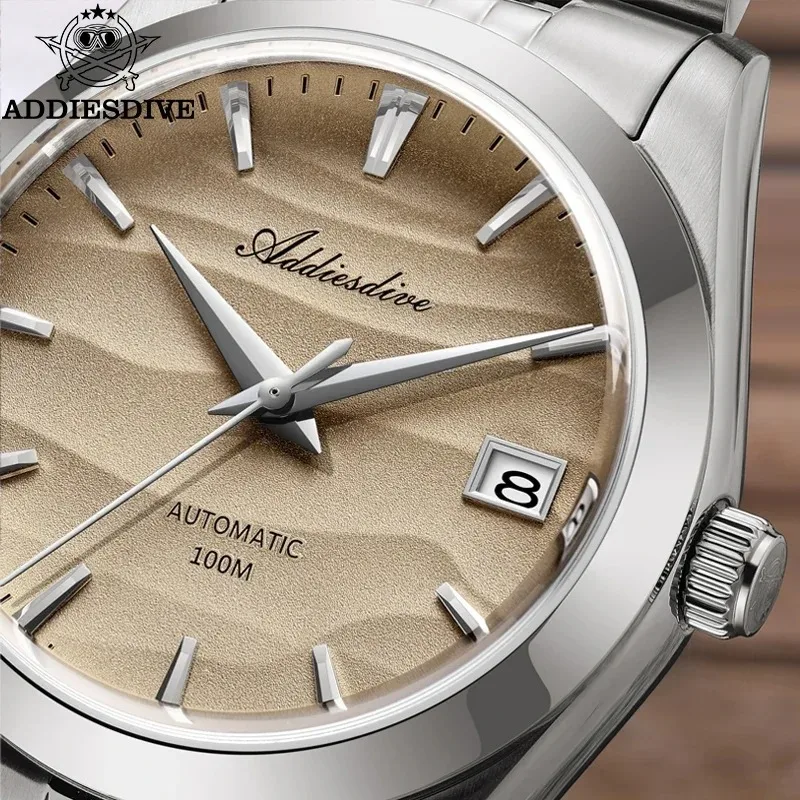
Dial Evolution
Contemporary dress watch dials balance tradition and innovation through:
- Subtle texture variations like clous de Paris or sunburst patterns
- Monochromatic color schemes with tonal variations
- Minimalist approaches that reduce elements to their essential forms
- Open-worked designs that reveal movement components while maintaining elegance
- Applied elements that create dimension without disturbing harmony
These approaches respect the category’s emphasis on restraint while introducing visual interest that rewards close inspection.
Modern Movements
Movement technology continues advancing in ways that benefit dress watches:
- Ultra-thin automatic calibers maintain convenience without compromising case profiles
- Extended power reserves eliminate daily winding concerns
- Silicon components improve magnetic resistance and longevity
- Improved shock protection enhances durability without increasing bulk
- Decorated movements visible through sapphire case backs add appreciation value
These technical improvements enhance the practicality of dress watches while maintaining their elegant proportions.
By balancing respect for tradition with thoughtful innovation, contemporary watchmakers ensure that dress watches remain relevant and desirable for today’s enthusiasts. The most successful examples demonstrate that evolution need not compromise the essential character that defines this enduring category.
Caring for Your Dress Watch
Proper maintenance ensures your dress watch remains both beautiful and functional for generations. Unlike robust sports watches, dress timepieces require thoughtful care that respects their refined nature and often delicate construction.
Daily Handling Practices
- Gentle winding: If manual, wind slowly and stop when resistance increases
- Crown care: Always push the crown fully in after setting or winding
- Clean hands: Handle with clean, dry hands to prevent oils and dirt transfer
- Cuff awareness: Be mindful when wearing with shirts to prevent scraping or catching
- Surface placement: Set your watch on soft surfaces, never crystal-down
Cleaning and Maintenance
- Regular wiping: Use a soft microfiber cloth to remove fingerprints and oils
- Case cleaning: Occasionally clean with a slightly damp cloth followed by thorough drying
- Crystal care: Clean sapphire with appropriate watch crystal cleaner
- Buckle maintenance: Pay attention to the clasp and buckle, which collect dirt and sweat
Leather Strap Preservation
Leather straps require special attention as they’re often the first element to show wear:
- Rotation: Alternate between multiple straps to extend their life
- Moisture avoidance: Remove the watch before showering, swimming, or heavy perspiration
- Air drying: If the strap gets wet, allow it to air dry naturally away from heat sources
- Conditioning: Occasionally treat fine leather with appropriate conditioner
- Storage: Keep unworn watches with leather straps flat rather than hanging
Professional Service
Even the finest dress watches require periodic professional attention:
- Service intervals: Follow manufacturer recommendations, typically every 5-7 years
- Water resistance: Have gaskets and seals checked if the watch has any water resistance rating
- Movement inspection: Professional cleaning prevents wear from accumulated oils and dust
- Bracelet maintenance: Occasional ultrasonic cleaning prevents dirt buildup in links
Storage Considerations
Proper storage protects your dress watch when not in use:
- Watch boxes: Use padded watch boxes or rolls for protection
- Humidity control: Store in environments with moderate humidity (40-60%)
- Automatic winders: Consider for automatic watches worn infrequently
- Magnetic protection: Keep away from electronic devices and magnetic closures
By following these care guidelines, your dress watch will maintain its elegant appearance and precise function for years to come, potentially becoming a cherished heirloom passed through generations.
Frequently Asked Questions About Dress Watches
What defines a true dress watch?
A true dress watch embodies elegance through simplicity—typically featuring a thin case (under 12mm), modest diameter (34-40mm), clean dial with minimal complications, and refined styling. The fundamental principle is understated sophistication that complements formal attire rather than competing with it.
Can a dress watch have a seconds hand?
Yes, a dress watch can have a seconds hand, though it’s often presented as a small seconds subdial rather than a central hand to maintain dial cleanliness. While the purest dress watches sometimes omit seconds hands entirely, this subtle addition remains well within traditional dress watch guidelines.
Are metal bracelets appropriate for dress watches?
Metal bracelets can be appropriate for dress watches when they maintain the same principles of refinement that define the category—slim profile, elegant design, and high-quality finishing. Mesh bracelets and thin, polished link designs work particularly well, though leather straps remain the most traditional choice.
How water resistant should a dress watch be?
Dress watches typically offer minimal water resistance (30-50 meters), sufficient for hand washing and rain exposure but not swimming or showering. This limited water resistance allows for thinner cases and more elegant crown designs, consistent with the category’s emphasis on refined proportions.
Can a dress watch be worn with casual clothes?
A dress watch can certainly complement casual attire, particularly business casual or smart casual ensembles. The versatility of a well-designed dress watch allows it to elevate casual outfits while still performing its primary role with formal wear. This adaptability makes dress watches excellent choices for varied wardrobes.
Are quartz movements acceptable in dress watches?
High-quality quartz movements are perfectly acceptable in dress watches, particularly when they allow for thinner case profiles or more accessible price points. While mechanical movements maintain traditional prestige, a well-executed quartz dress watch that adheres to the category’s design principles can be an excellent choice.
What’s the difference between a dress watch and a dress-casual watch?
A pure dress watch adheres strictly to formal design principles with minimal complications and conservative styling, while dress-casual watches incorporate slightly sportier elements like increased water resistance, additional complications, or more contemporary materials while maintaining refined aesthetics suitable for business environments.
How much should I expect to spend on a quality dress watch?
Quality dress watches exist across a wide price spectrum. Entry-level options from reputable manufacturers start around $200-500, mid-range options from established brands range from $1,000-5,000, and luxury examples from prestigious manufacturers can reach well into five figures or beyond. The key is finding well-executed design within your budget.
Why Invest in a Quality Dress Watch
A quality dress watch represents more than just a timekeeping device—it’s an investment in craftsmanship, personal style, and lasting value that transcends fleeting trends. Understanding the value proposition of these refined timepieces helps appreciate why they deserve consideration in any watch collection.
Artisanal Value Beyond Mass Production
In an age dominated by mass-produced consumer goods, fine dress watches stand apart through:
- Hand-finished components requiring skilled craftsmanship
- Mechanical movements representing centuries of horological tradition
- Careful assembly by trained watchmakers rather than assembly lines
- Meticulous quality control and regulation
These watches embody human skill and attention to detail increasingly rare in our digital world, creating objects with soul and character beyond their functional purpose.
Style Investment Transcending Trends
Unlike fashion accessories that quickly become dated, quality dress watches offer:
- Timeless design languages that remain relevant across decades
- Versatility that complements evolving wardrobes and styles
- Understated elegance that never appears ostentatious or outdated
- Distinctive character without succumbing to fleeting trends
This enduring aesthetic value ensures your investment remains relevant and appropriate throughout a lifetime of use.
Quality That Justifies Investment
The superior materials and construction of fine dress watches deliver tangible benefits:
- Precious metals that develop character while maintaining beauty
- Sapphire crystals that resist scratches through years of daily wear
- Movements engineered for decades of reliable service
- Construction techniques ensuring generations of functionality
- Materials selected for beauty that improves with age
These quality elements create timepieces that often improve rather than deteriorate with careful use, potentially becoming more valuable over time.
The Emotional Dimension
Perhaps most significantly, dress watches foster connections beyond their physical attributes:
- They mark significant life achievements and milestones
- They create daily rituals through winding and wearing
- They develop personal histories and associations
- They connect wearers to traditions of craftsmanship and excellence
- They often become cherished heirlooms passed between generations
This emotional dimension transforms dress watches from mere possessions into meaningful artifacts that carry stories and memories throughout a lifetime.
The perfect dress watch doesn’t merely tell time—it tells your story, expresses your values, and connects you to traditions of excellence that transcend our disposable culture. This combination of tangible quality and intangible significance makes a fine dress watch a uniquely rewarding investment that pays dividends in satisfaction far beyond its initial cost.

